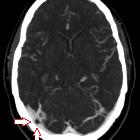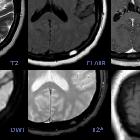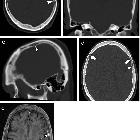Pacchionian granulation





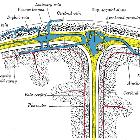

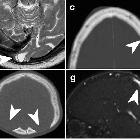
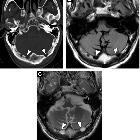
















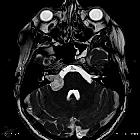
Arachnoid granulations, also known as Pacchionian granulations, are projections of the arachnoid membrane (villi) into the dural sinuses that allow CSF to pass from the subarachnoid space into the venous system.
Epidemiology
They increase in size and number with age and are seen in approximately two-thirds of patients.
Pathology
Location
They most frequently occur in a parasagittal location with the transverse and superior sagittal sinuses being the most common locations. The granulations typically occur next to the entrance of a superficial draining cortical vein into a sinus (similar to colonic diverticula occurring next to penetrating vessels).
Radiographic features
They are most commonly encountered in radiological practice as incidental osteolytic, sharply circumscribed indolent-appearing lucencies on skull CT or x-rays, or a filling defect in dural venous sinuses, which can be mistaken for dural venous thrombosis.
CT
The granulations are typically of CSF density and protrude into the calvaria or a dural venous sinus causing a filling defect. They may simulate a dural venous sinus thrombosis but are usually easy differentiated given their round well-defined shape and classic location.
MRI
Signal characteristics are generally those of CSF :
- T1: low signal intensity
- T2: high signal intensity; iso- or even slightly hyperintense to CSF
- FLAIR: should attenuate
- T1 C+ (Gd): no enhancement
Giant granulations (>10 mm) may show atypical MRI signal characteristics, with higher T1 and T2 signal than CSF and incomplete FLAIR signal suppression . Rarely these may cause sinus obstruction .
History and etymology
Arachnoid granulations are named after Antonio Pacchioni (1665-1726), an Italian physician, who wrote extensively on the anatomy of the dura mater, and provided the first written description of his eponymous granulations in 1705 in the Dissertatio Epistolaris de Glandulis Conglobatis Durae Meningis Humanae, one of his monographs .
Differential diagnosis
Considerations include
On CT if there is lytic erosion of the bone also consider
- small calvarial metastases/myeloma/plasmacytoma etc.
or rarely
- intradiploic epidermoid - often centered towards the mid to outer margins of the skull
See also
Siehe auch:
- Sinusthrombose
- solitäre lytische Läsion des Schädels
- Dura mater
- venöse Kanäle und Lakunen der Kalotte
- Venae diploicae
- Fett in den intrakranialen venösen Sinus
- Pacchionische Granulationen in den duralen venösen Sinus
- Herniation von Hirngewebe in durale Sinus
und weiter:

 Assoziationen und Differentialdiagnosen zu Pacchionische Granulationen:
Assoziationen und Differentialdiagnosen zu Pacchionische Granulationen: